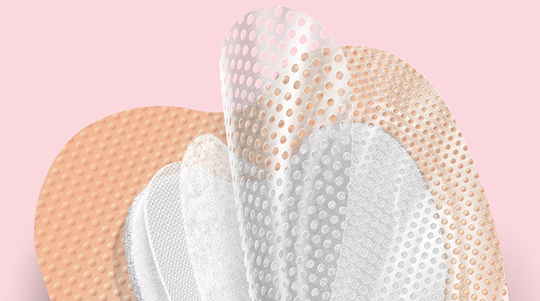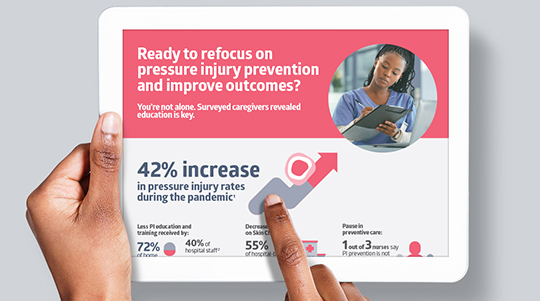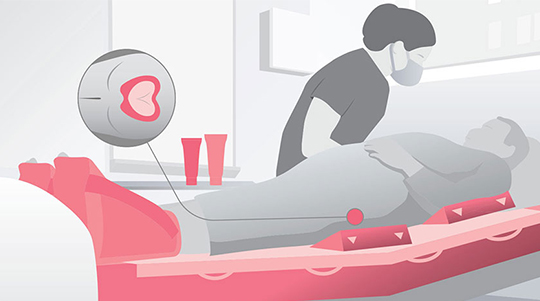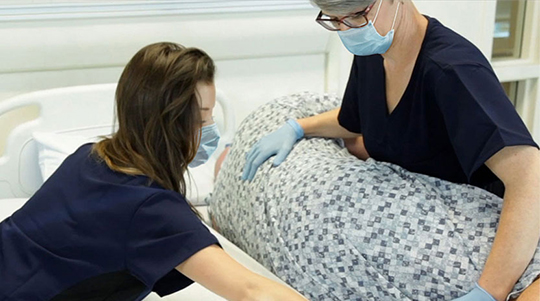How can a dressing help reduce shear and friction better?
Learn how a layered wound care dressing helps fight shear and friction for patients at risk for skin breakdown.
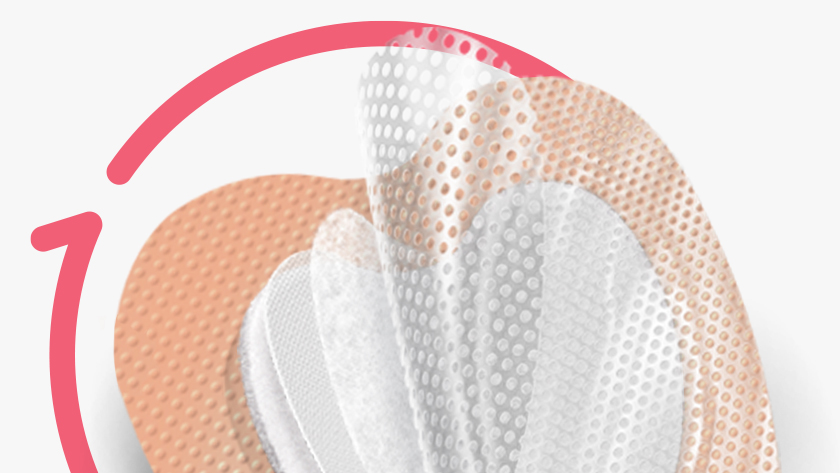
Caregivers want to stop pressure injuries—sometimes called “pressure sores”—before they start. But how do you do that? You can turn to multilayer foam dressings to keep at-risk patients safe. In addition to protecting skin from shear and friction—the forces that contribute to pressure injuries—the layers work together to advance healing by managing exudate and guarding the wound against further trauma.
Do you know the difference between shear and friction?
Shear
What it is: It’s defined as the “mechanical force that acts on an area of skin in a direction parallel to the body’s surface.”
How it leads to skin breakdown: In the case of a sacral pressure injury, this wound occurs when the bones of the pelvis are pulled in one direction and the skin in the opposite. Often internal damage caused by shear is not visible.
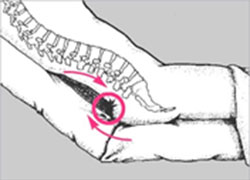
Friction
What it is: It’s defined as “the mechanical force exerted when skin is dragged across a coarse surface such as bed linens.”1
How it leads to skin breakdown: Although friction is often necessary for patients to sit upright in bed, gravity can cause problems. As gravity pulls on the upper torso, skin resists the movement because of friction with the surface. As Cathy Thomas Hess, BSN, RN, CWOCN puts it in Advances in Skin & Wound Care, this extra stress on the body, particularly on the sacral area and heels, “can cause damage to the inner layer of connective tissue and limits blood flow to the region, resulting in tissue necrosis.”1 Friction can cause surface damage on the skin and lead to tears and fissures.
Tissue may be damaged due to both the forces of friction and shear working together, combined with pressure.1 This is often a risk for older people, but also for critical care patients and newborns.2 Additionally, a less-than-optimal microclimate between the body and the surface can exacerbate the decline in skin integrity.3
5-layer foam dressings: A proven tool for fighting shear and friction
As a clinician, you have many pressure injury prevention products to help control friction and shear and manage microclimate. One of those is a multilayer foam dressing. “The material is unique in that I can compress and redistribute shear across the dressing and beyond,” says Dr. Kevin Woo, PhD, RN, NSWOC, FAPWCA, Medline consultant and associate professor, Queen’s University, School of Nursing, School of Rehabilitation Therapy in Kingston, Ontario, Canada.
“The five-layer foam dressing helps manage the frictional forces associated with pressure injury development, which will also help to lower the potential for shear,” emphasizes Medline Clinician Patricia Turner, BSN, RN, CWOCN, CWS, adding, “These dressings also manage microclimate which is the temperature and humidity of the skin and the dressing interface.”
“Using a five-layer dressing as part of an overall pressure injury prevention protocol can help prevent and treat skin breakdown.”

Patricia Turner
BSN, RN, CWOCN, CWS and Medline clinician
When to use it
Turner stresses that a five-layer dressing is not needed on every patient. They work best for patients with specific PI risk factors and should be reserved for bony prominences. She encourages staff to develop a decision tree or internal guidelines based on patient condition.
“Each facility should empower nurses to use critical thinking or risk factor assessments to determine which patients will benefit from a five-layer foam dressing and which patients should receive a different option,” according to Turner. “Using a five-layer dressing as part of an overall pressure injury prevention protocol can help prevent and treat skin breakdown,” she adds. “It is an added tool in nurses’ toolbox of wound care.”
She continues, “It’s a matter of the right product for the right patient at the right time.”
As an added benefit, Dr. Woo points out that patients and families can learn how to use foam dressings at home without specialized help.
What to look for in a wound dressing:
- Potential benefit of the dressing
- Maintains a moist wound environment
- Excellent fluid handling capacity
- Ability to maintain the dressing in place
- Patient preference
- Comfort
- Non-allergenic materials
- Cost effectiveness and accessibility of the dressing
- Appropriateness of size and shape
- Ease of application and removal
- Ability to regularly assess the skin under the dressing
- Coefficient of friction at the skin-dressing interface
Is there a cost savings?
“For pressure injury prevention, it’s not a single intervention approach but a bundled approach—and you can add multilayer foam dressing to the bundle cost effectively,” Dr. Woo notes.
“For pressure injury prevention, it’s not a single intervention approach but a bundled approach—and you can add multilayer foam dressing to the bundle cost effectively,”

Dr. Kevin Woo
PhD, RN, NSWOC, FAPWCA, Medline consultant and associate professor, Queen’s University, School of Nursing, School of Rehabilitation Therapy in Kingston, Ontario, Canada.
As Turner puts it, “Preventing a pressure injury helps save the overall cost of developing a PI and having to take care of it.”
A study to examine the effectiveness and value of five-layer foam sacral dressings to prevent hospital-acquired pressure injury (HAPI) rates in acute care settings found that facilities could not only reduce HAPIs, but also save money: up to $600,000 in expenses associated with pressure injuries. The study states that using a specific product to address pressure injuries can focus caregivers’ attention on opportunities to reduce risk. As the authors put it, “Investment in a tangible product as part of a pressure injury prevention bundle results in staff who are more aware of this concerning issue and feel supported in their efforts to prevent pressure injuries.”4
Why clinicians recommend this proven foam dressing
Why do clinicians use Optifoam Gentle as a primary or secondary dressing for partial- or full-thickness wounds? Studies have shown that this foam dressing outperforms other dressings, demonstrating the following benefits:3,5
- Demonstrating the lowest average shear force
- Transferring less shear to the skin when external shear force was in place under compression
- Relieving residual shear better when the force was removed
Another benefit that Turner points out: “Medline’s Optifoam Gentle dressing stays on the skin for the desired time and is easy to remove when changing.” That’s due to a specially formulated silicone adhesive.
Optifoam’s five unique, purposeful layers
- Silicone layer minimizes trauma to the wound with gentle adhesion.
- Super absorbent layer effectively absorbs and retains exudate, reducing the risk of maceration.
- Transfer layer helps move fluids and moisture into the super absorbent layer and helps prevent leakage.
- Foam layer absorbs exudate to minimize pooling at the wound surface.
- Highly breathable film acts as a waterproof barrier that seals the wound from germs and dirt.
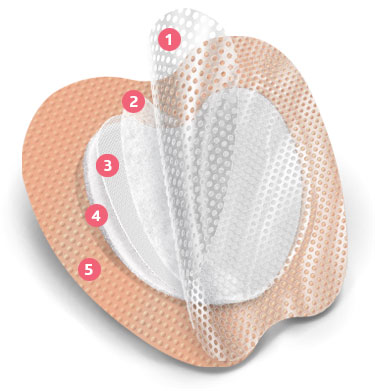
Key takeaway
Using a five-layer dressing for wounds as part of an overall pressure injury prevention protocol is a cost-effective intervention that can keep patients safe. It helps protect against friction and shear and prevent the skin breakdown that leads to PIs. Look for a proven foam dressing that helps ease the pain and trauma of dressing changes.
References:
- Hess, C. T. (2004). DID YOU KNOW? The Difference between Friction and Shear. Advances in Skin &Amp; Wound Care, 17(5), 222. https://doi.org/10.1097/00129334-200406000-00006
- NPIAP, Prevention and Treatment of Pressure Ulcer/Injuries: Clinical Practice Guideline. 2019: 145-150.
- Call, Evan, MS, CSM-NRM, “Friction and Shear Displacement Analysis of Sacral Foam Dressings: Optifoam Gentle SA, Mepilex and Allevyn Life.” Data on file.
- “Biomechanical Evaluation of Wound Dressings Based on their Ability to Mediate the Transmission of Shear Loads That May Lead to Decubitus Ulcers.” Data on File.
- Padula WV. Effectiveness and Value of Prophylactic 5-Layer Foam Sacral Dressings to Prevent Hospital-Acquired Pressure Injuries in Acute Care Hospitals: An Observational Cohort Study. J Wound Ostomy Continence Nurs. 2017;44(5):413-419. doi:10.1097/WON.0000000000000358
